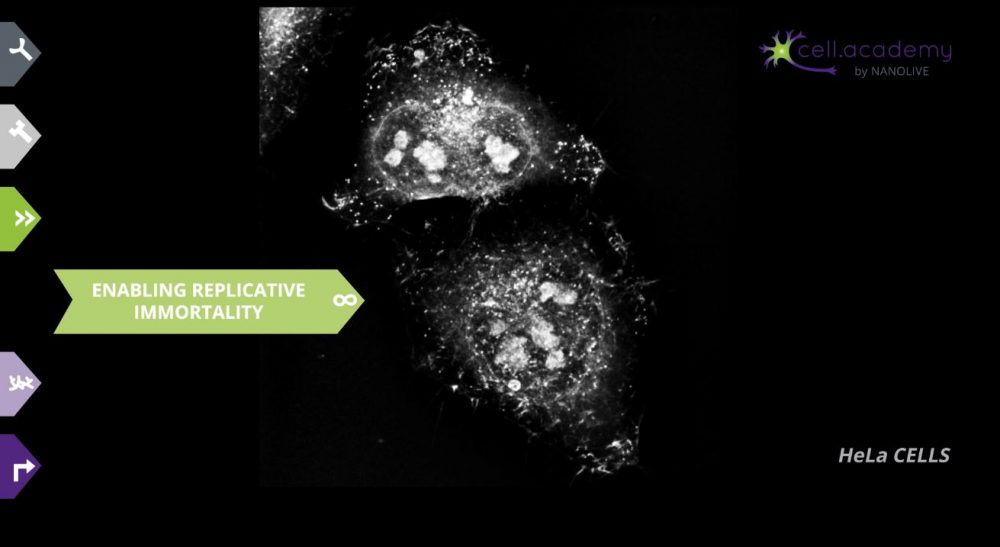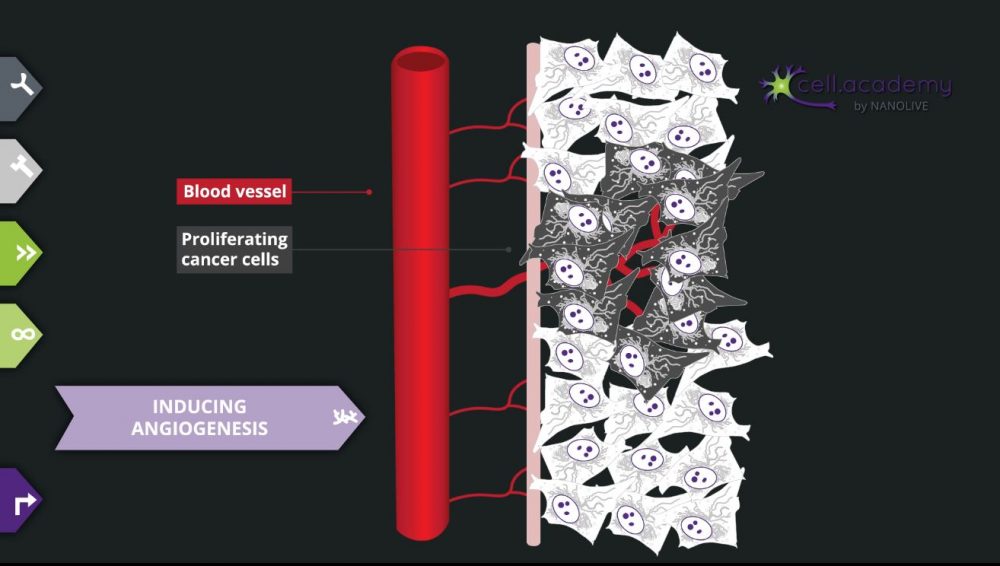What is cancer? Cancer is when abnormal cells divide in an uncontrolled way. Sounds simple, right? Well, not really. Abnormalities are generally due to gene changes which impact the cell cycle. There are over 100 different types of cancer, so finding a unique cure is very difficult. However, in the year 2000, researchers Douglas Hanahan and Robert Weinberg published a ground-breaking paper with 6 properties that all cancerous cells have in common, which they called hallmarks. In this video, we will be explaining these 6 different hallmarks and illustrating them with videos of living cancer cells – because, live cells are amazing!
#1 Sustaining proliferative signaling
Let’s start with the first and most fundamental hallmark: Sustaining proliferative signaling. Cells have a receptor at their surface which, when receiving a growth factor signal from neighboring cells, initiates an intracellular cascade of signaling which leads to cell growth and division. Cells normally need this feedback from other cells to know when to divide, ensuring that proliferation happens in a coordinated manner.

Cancer cells are able to divide even without receiving these signals which leads to an uncontrolled proliferation of these abnormal cells. It is often a mutation in the receptor’s gene that maintains a growth signaling cascade – even in absence of the signal. At each replication cycle, the mutation is passed onto the daughter cells. This uncontrolled proliferation could eventually lead to the formation of a mass which we call a tumor.

#2 Evading growth suppressors
Which leads us to the second hallmark: evading growth suppressors. In order to maintain homeostasis, along with growth factors, cells can also produce growth suppressors which act as a stop signal for themselves or on neighboring cells if they are growing in an uncoordinated fashion. However, cancer cells, stubborn as they are, happen to ignore these “anti-growth signals” just like a speeding car going through a red light. This, also contributes to continuous proliferation of the cancerous cells.

#3 Resistance to cell death
So, these mutated cells are dividing without control, and as we saw in the previous video on cell death which you can watch on our channel, cells have an internal sensor to detect dangerous mutations, and initiate apoptosis to eliminate faulty cells through cell suicide. So you would think that these mutated cells would eventually die, right? Well that would be the ideal solution, however, the third hallmark of cancer is the resistance to cell death. Cancer cells often have a mutation in one of the signaling proteins leading to cell death, which helps them evade this fate.

#4 Enabling replicative immortality
If you remember, in the cell death video I had also mentioned that cells have a natural expiry date after which they are destined to die. But don’t get your hopes up, because it so happens that the fourth hallmark of cancer is enabling replicative immortality, in other words – some cancer cells overcome this expiry date and can divide indefinitely rendering them…. Immortal. Henrietta Lacks was a patient who died of cancer in 1951, and a cancer cell line called HeLa was derived from her cervical cancer cells and this line is still being widely used in research today due to its immortality.

#5 Inducing angiogenesis
Cell growth and division require a lot of energy which is provided in form of nutrients and oxygen from the surrounding blood vessels. So, you would think that at some point, cancer cells would not have enough resources to divide endlessly, especially if they are packed up in a tumor. Well, cancer cells secrete molecules which stimulate blood vessel growth. This process is called angiogenesis and is the fifth hallmark of cancer. This creates a larger network of vasculature around and within the tumor and provides the cells sufficient nutrients and oxygen to keep growing. Angiogenesis is a vital process in development that is usually activated during wound healing, but microenvironmental changes cause it to be activated in cancer cells as well.

#6 Activating invasion and metastasis
The sixth hallmark is also the event that most often leads to death: activating invasion and metastasis. At this stage, the cancerous cells not only invade neighboring tissues but also activate metastasis -which means these cells can now migrate through the blood and spread all around the body and eventually form new tumors in other locations. Therefore, it is difficult to locate them and provide focused treatment. I guess you’re starting to understand why it’s so complex to find a cure against cancer.

These six properties are all due to genetic modifications or changes in the microenvironment surrounding the cells that accumulate over time. It has now been 19 years since these hallmarks were established and even though they remain fundamental, more have been discovered since. Cancer is a vast field of research and new discoveries are made daily. Understanding these underlying mechanisms has already helped make great progress in the field of cancer therapy, as each hallmark is a potential target for treatment.
Do you know of any other hallmarks of cancer? Let me know in the comments below and head over to cell.academy to see the images of cancer cells we showed in this video… and don’t forget to subscribe to our channel.
References:
Hanahan, D., & Weinberg, R. A. (2000). The Hallmarks of Cancer. Cell, 100(1), 57–70. https://doi.org/10.1016/s0092-8674(00)81683-9
Collins, K., Jacks, T., & Pavletich, N. P. (1997). The cell cycle and cancer. Proceedings of the National Academy of Sciences, 94(7), 2776–2778. https://doi.org/10.1073/pnas.94.7.2776
Cooper GM. The Cell: A Molecular Approach. 2nd edition. Sunderland (MA): Sinauer Associates; 2000. The Development and Causes of Cancer. Available from: https://www.ncbi.nlm.nih.gov/books/NBK9963/
Duesberg, P., & McCormack, A. (2013). Immortality of cancers. Cell Cycle, 12(5), 783–802. https://doi.org/10.4161/cc.23720
Pereira, B., & Ferreira, M. G. (2012). Sowing the seeds of cancer. Current Opinion in Oncology, 1. https://doi.org/10.1097/cco.0b013e32835b6358
Seyfried, T. N., & Huysentruyt, L. C. (2013). On the Origin of Cancer Metastasis. Critical Reviews in Oncogenesis, 18(1–2), 43–73. https://doi.org/10.1615/critrevoncog.v18.i1-2.40
Hainaut, P., & Plymoth, A. (2013). Targeting the hallmarks of cancer. Current Opinion in Oncology, 25(1), 50–51. https://doi.org/10.1097/cco.0b013e32835b651e
https://www.nature.com/scitable/topicpage/cell-division-and-cancer-14046590
